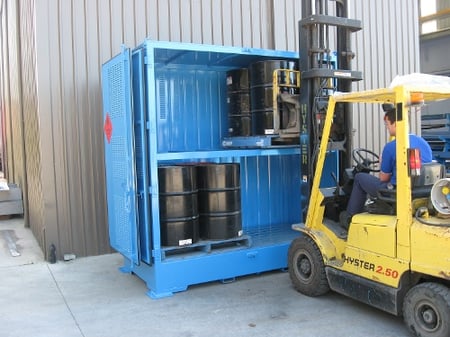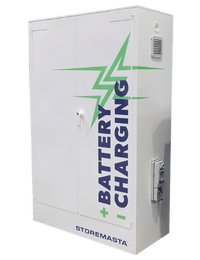There’s a lot of information available online about the risks associated with lithium-ion (Li-ion) batteries. From viral videos showing e-cigarettes combusting to stories about planes being affected by exploding batteries, it’s natural to be concerned about the risks that these high-tech batteries pose. However, Li-ion batteries can be managed in a safe, sensible and simple way by understanding what you need to do in your workplace to avoid incidents such as lithium-ion battery fires. This blog is dedicated to helping you reduce your risk by offering 5 tips to stay safe when transporting, handling and storing lithium-ion batteries.
Where Do You Find Li-Ion Batteries?
Hundreds of millions of lithium-ion batteries are being used in Australia every year, with the global demand for Li-ion batteries continuing to grow due to the popularity of electric vehicles and high-tech devices.

Li-ion batteries are used to power a wide range of power tools and equipment, including forklifts.
L-ion batteries are required for a broad range of technology and equipment, including:
- Electric vehicles, trucks and bikes
- Mobile phones
- Laptop computers and devices
- Solar energy storage
- Forklifts
- Medical equipment
- Electric tools
- Cameras
- Drones
- Security and alarm systems
What Problems Can Li-Ion Batteries Pose In The Workplace?
When you’re dealing with lithium-ion batteries in your business, it’s important to understand what can go wrong when the battery is mishandled, stored incorrectly or transported in an unsafe way.
Due to the temperature sensitivity of Li-ion batteries, they can be capable of overheating and sparking thermal runaway. This process will quickly lead to a lithium-ion battery fire or explosion. Li-ion batteries may also malfunction and cause a serious accident in the workplace, if they are damaged, aged or have a manufacturing fault. Charging faulty or damaged batteries can set off a chemical chain reaction, with hazardous consequences for your business if there aren’t any control measures in place.
When handling, storing and transporting your lithium-ion batteries, you must always refer to the Safety Data Sheet of your battery or the manufacturer’s instructions. You’ll need to be aware of the stability and reactivity of the battery, its incompatibility with other hazardous materials, the acute and chronic health hazards associated with the battery, and fire fighting and explosion hazard data.
Generally, Li-ion batteries should not be handled, transported or stored in an environment where there is:
- Excessive heat
- Direct sunlight
- Exposure to fire or open flame
- Smoking
- Lack of ventilation
- Overcharging
- Deep discharging
- Short circuiting
- Tampering or damage to the battery
Failure to meet these requirements can result in your battery cell becoming unstable, resulting in the rupturing, ignition or explosion of your Li-ion battery (as well as your entire battery store).
How Can You Reduce Risk?
With these battery hazards in mind, we’ll now list 5 ways you can reduce the various risks associated with Li-ion batteries.
1. Contain Battery Leaks
Just like a lead-acid battery or regular household battery, you should always be careful not to handle Li-ion batteries that are leaking. While battery leaks are infrequent in lithium-ion batteries, they can still occur if the battery has suffered substantial impact or damage.
Electrolyte can leak out of Li-ion batteries if the battery housing suffers damage. Care must be taken to protect workers (through the use of PPE and following workplace procedures) from the hazards associated with leaking electrolyte. Battery leaks will cause skin irritation and eye damage if workers aren’t using the correct PPE. Li-ion battery leaks can also result in environmental contamination if the battery is not disposed of safely.
You can effectively contain battery leaks in your lithium-ion battery stores with a liquid-tight spill containment sump. Just like any type of hazardous chemical spill, your storage equipment should be manufactured to contain battery leaks, so leaks don’t reach your workplace or the surrounding environment.
Containing battery leaks will reduce the risk of skin and eye irritation, as well as chronic health effects.
2. Provide A Cool, Dry Environment
As this type of battery is sensitive to heat, it’s vital that you provide a cool, dry climate in your battery handling and charging areas.
Using temperature-control systems, air conditioning and fans in your work areas and storage facilities can help keep batteries at a safe temperature and reduce the risk of overheating.
Humidity, as well as heat, is a risk factor for lithium-ion batteries. Therefore, you should make sure that your batteries are never exposed to extreme humidity, as this can affect the integrity and safety of the battery.
3. Avoid Overcharging
One of the most important safety tips with Li-ion batteries is to avoid overcharging. If you check the SDS of your lithium-ion battery products, you’ll generally find advice on how to avoid the hazards associated with overcharging your battery.
While monitoring your batteries while they’re charging is a crucial safety measure, you should also avoid deep discharging your batteries. Even when batteries are fully discharged, they can pose risks, including electric shock. Follow the manufacturer’s instructions and warnings, and never use battery chargers which are not suitable for your Li-ion battery.
Refer to the handling and operational safety instructions of your SDS to learn more about other risky charging and discharging behaviours such as maximum current load, mechanical and thermal loads, and charging and end-point voltages.

To reduce the risk of fire, make sure you avoid overcharging and over discharging your batteries.
4. Don’t Leave Batteries Lying Around
Your workplace should have a designated space for your chemicals, your tools and your PPE. So, why not your lithium-ion batteries?
Li-ion batteries should never be left lying around a worksite, as this increases the risk of the battery being overheated or mishandled. Choose a battery cabinet or store that is only used to house Li-ion batteries. Ensure the environment of the store is cool and dry, and that all electrical equipment and chargers are fit-for-purpose.
By providing a battery cabinet for your staff to use, you’ll also be reducing the likelihood of the batteries going missing, being stolen or suffering damage.
5. Choose A Well-Ventilated Space
Have you provided sufficient ventilation for your Li-ion batteries? To assist with the safe storage and charging of workplace batteries, you should also ensure that your space is adequately ventilated.
Ventilation helps keep your batteries at a safe temperature, and it can also decrease the impact upon the people in your organisation if a battery fire did occur.
Li-ion batteries contain hazardous chemicals, including flammable electrolyte, copper, aluminium, lithium and other substances. In the event of a battery fire, dangerous and highly toxic gases will be emitted. These gases can quickly consume a building and affect the respiratory system of workers and emergency crews. In addition to this risk of human harm, the gas can ignite and cause an explosion.
In the event of a lithium-ion battery fire, sufficient ventilation of battery stores can reduce the impact on human health. However, self-contained breathing apparatus should always be worn by any person who is attempting to extinguish a Li-ion battery fire.
Reducing Risks With Li-Ion Batteries
With more businesses relying on Li-ion batteries to power their technology, vehicles and equipment, it’s crucial that staff are aware of the hazards associated with this type of workplace battery. As we’ve mentioned in this blog, by providing a dedicated, cool, dry and well-ventilated space for your batteries, you can minimise the likelihood and impact of a battery fire or explosion. If you’re using multiple Li-ion batteries in your workplace, choosing a battery charging and storage cabinet can improve the safety of your operations. It also allows your staff to operate more confidently and quickly, as they will have a specific space in which to safely charge and store the lithium-ion batteries.
To find out more about reducing risk in your Li-ion battery stores, why not download our free eBook? Guide to the Safe Charging and Storage of Lithium-ion Batteries explains what you need to do to ensure that your batteries are being handled and stored in a way that minimises the likelihood of fire, explosion and thermal runaway. Grab your free copy now by clicking on the image below.

Living life by the 4 C’s of marketing – communication, coffee, compliance… and more coffee – Leisa Andersen is Storemasta’s Content Marketing Manager. When she’s not writing, you’ll find her enjoying all the good things in life, including shopping, travel and gluten free donuts.

